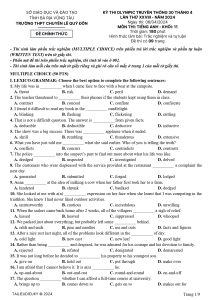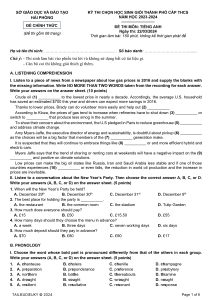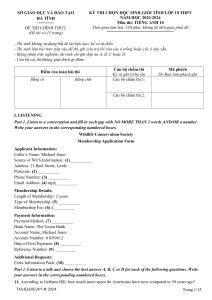Tài liệu diệu kỳ giới thiệu Đề thi HSG Tiếng Anh 12 TP Hồ Chí Minh năm học 2023-2024 có đáp án có thể tải xuống file word và pdf thi ngày 05/03/2023 do sở GD&ĐT TP HCM tổ chức. Nhìn chung, đề thi chọn học sinh giỏi lớp 12 cấp thành phố môn Tiếng Anh năm nay có cấu trúc tương tự so với các năm trước. Đề thi gồm 4 trang, thí sinh làm bài trong 120 phút.
Thầy cô và các bạn học sinh có thể tham khảo đường dẫn phía dưới để download tài liệu để ôn luyện và chuẩn bị cho Kỳ thi học sinh giỏi cấp thành phố năm học 2024-2025.
Đề thi HSG tại TP HCM năm 2023 gồm 105 câu hỏi, tổng điểm toàn bài được quy đổi về 20. Dưới đây là cấu trúc đề thi:
I. USE OF ENGLISH - 20 points
Choose correct words or phrases to complete sentences. (20 questions)
II. WORD FORMS - 40 points
Use words correctly and fill in blanks with appropriate words. (20 questions)
III. GUIDED CLOZE TEST - 30 points
Fill in blanks with suitable words in a passage. (15 questions)
IV. OPEN CLOZE TESTS - 60 points
Fill in blanks in passages. (30 questions)
V. READING COMPREHENSION - 20 points
Answer questions based on a passage. (10 questions)
VI. SENTENCE TRANSFORMATION - 30 points
Rewrite sentences using given words while maintaining meaning. (10 questions)

Đề thi HSG Tiếng Anh 12 TP Hồ Chí Minh năm học 2023-2024 - Trang 1/4
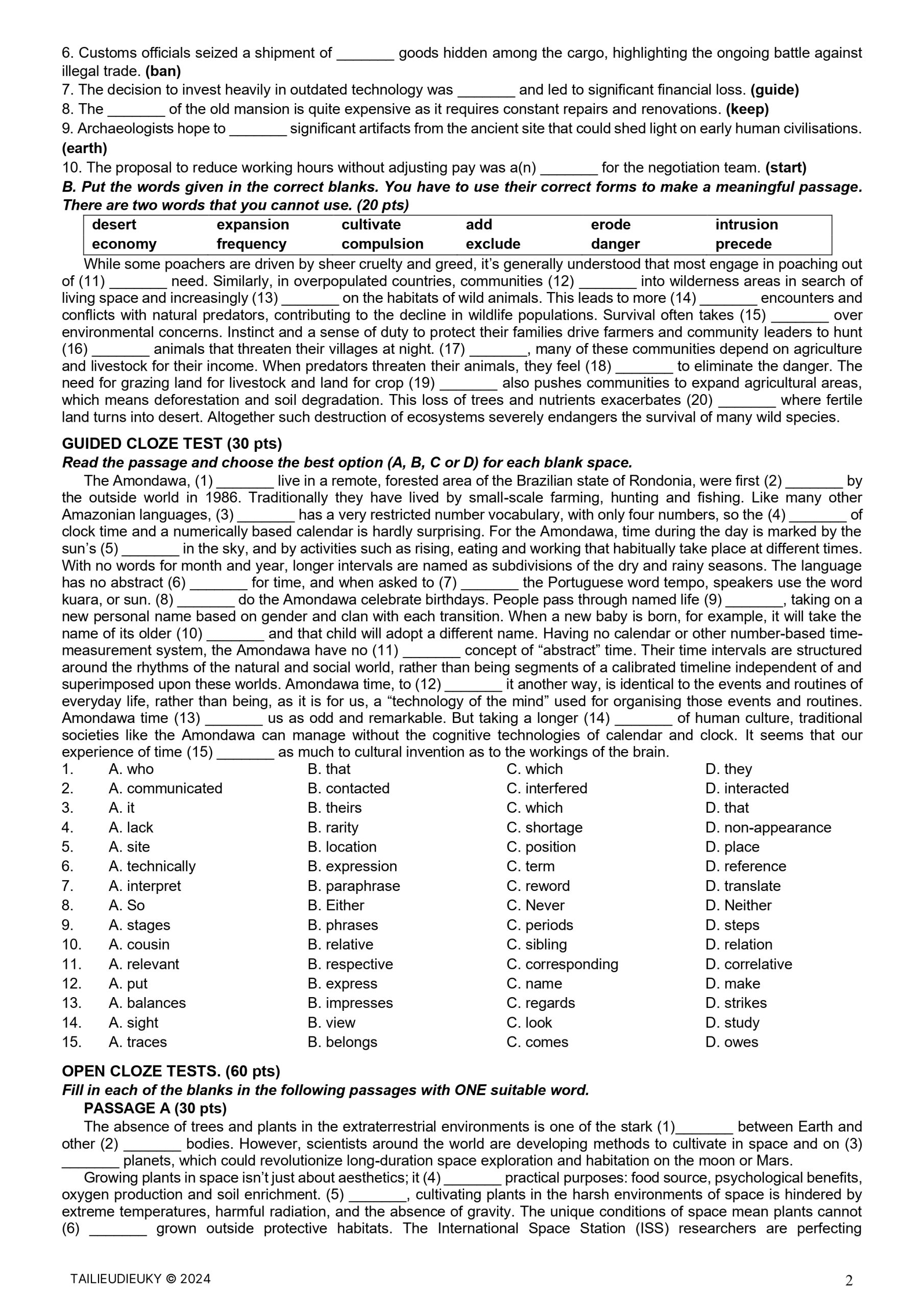
Đề thi HSG Tiếng Anh 12 TP Hồ Chí Minh năm học 2023-2024 - Trang 2/4
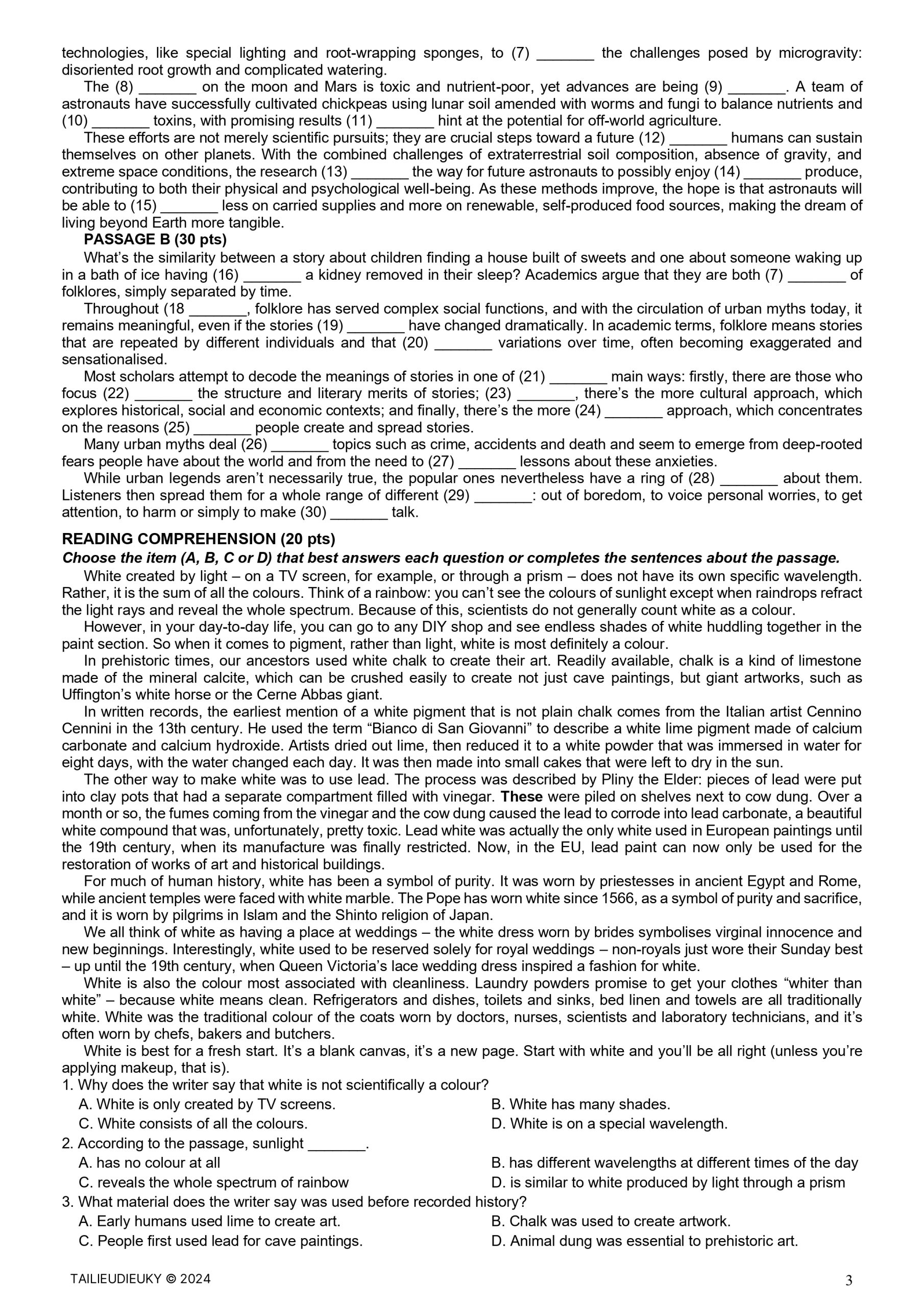
Đề thi HSG Tiếng Anh 12 tỉnh Hà Tĩnh năm học 2023-2024 có đáp án - Trang 3
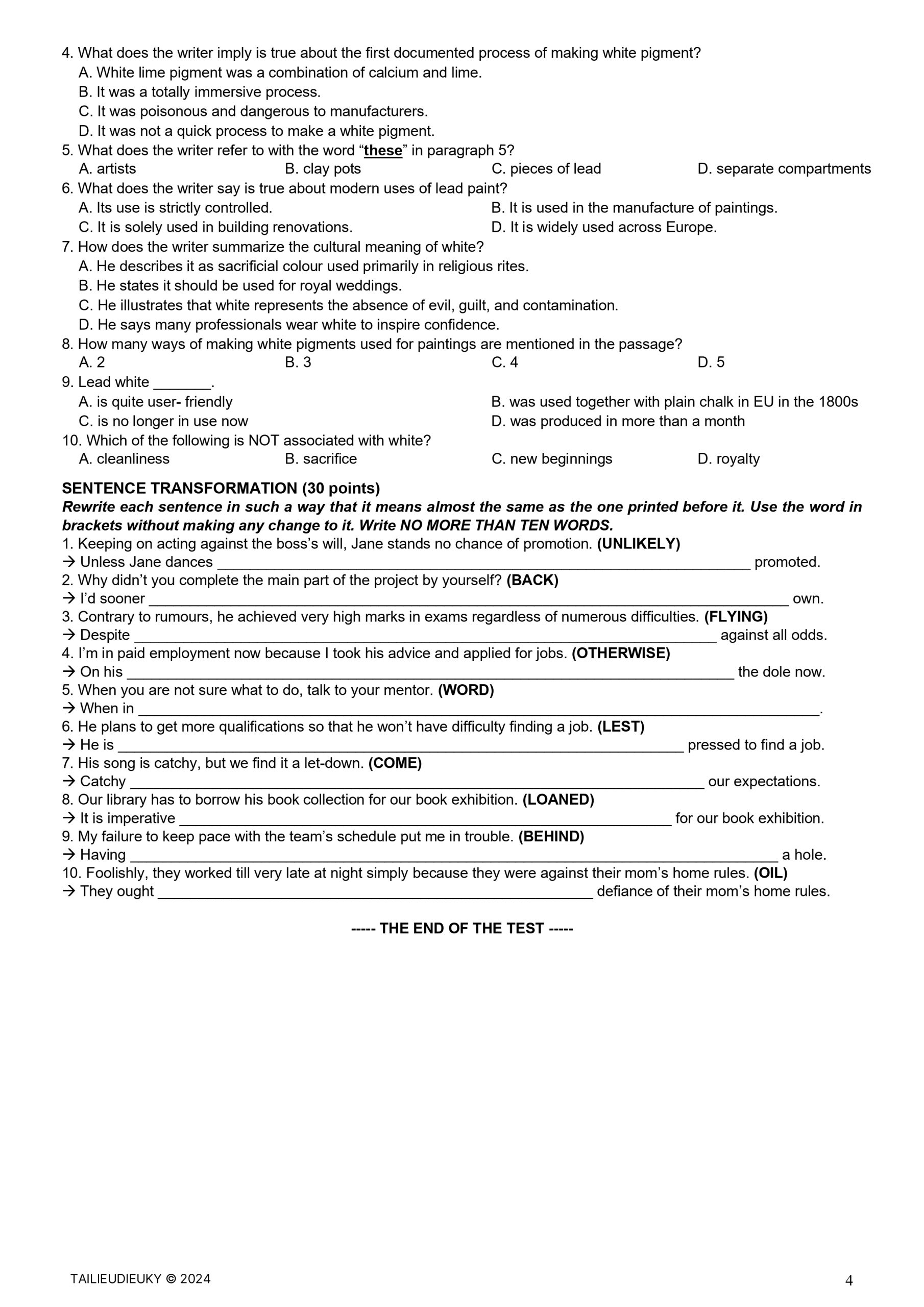
Đề thi HSG Tiếng Anh 12 tỉnh Hà Tĩnh năm học 2023-2024 có đáp án - Trang 4
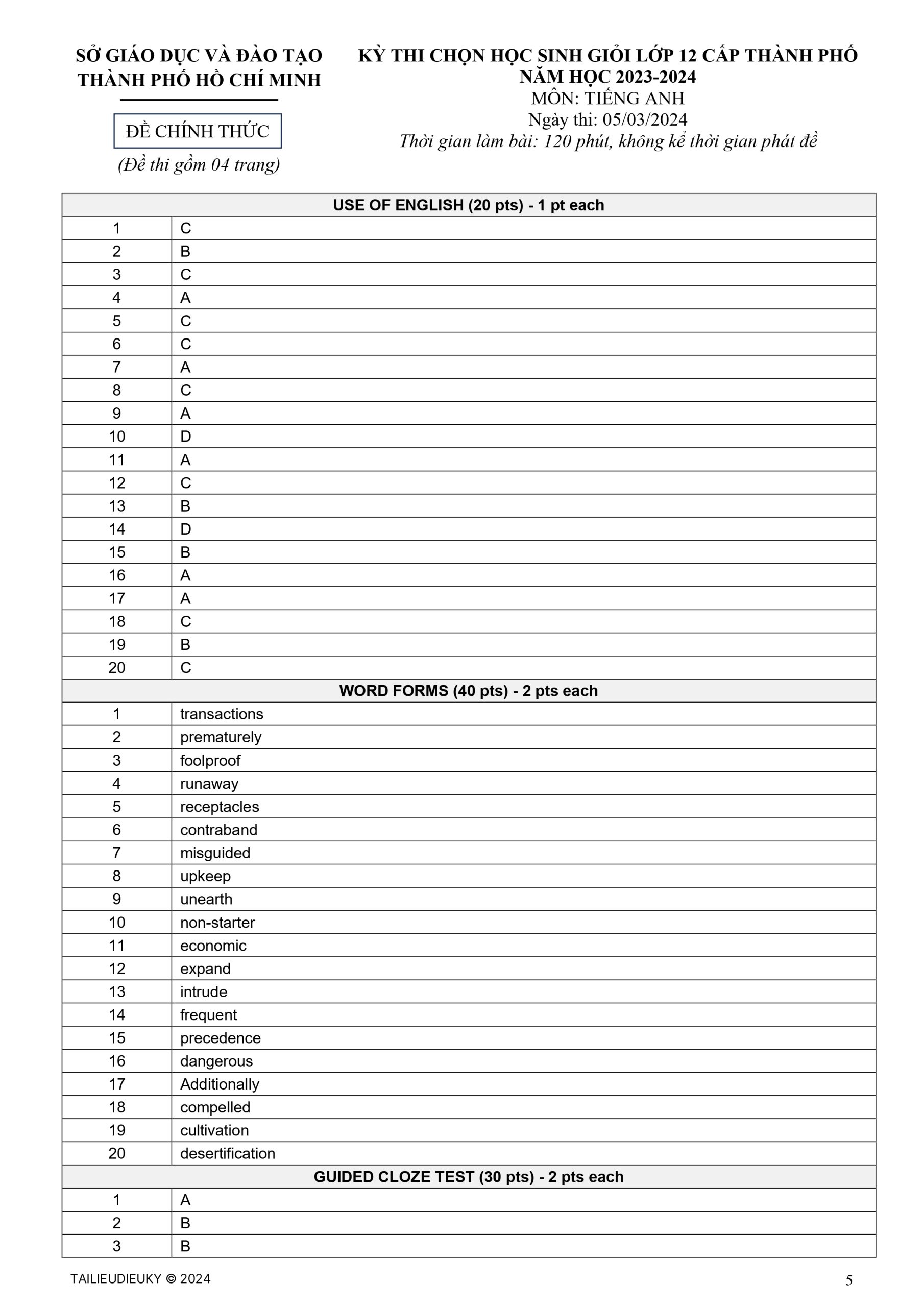
Đáp án chính thức - Đề thi HSG Tiếng Anh 12 TP Hồ Chí Minh năm học 2023-2024 - Trang 1
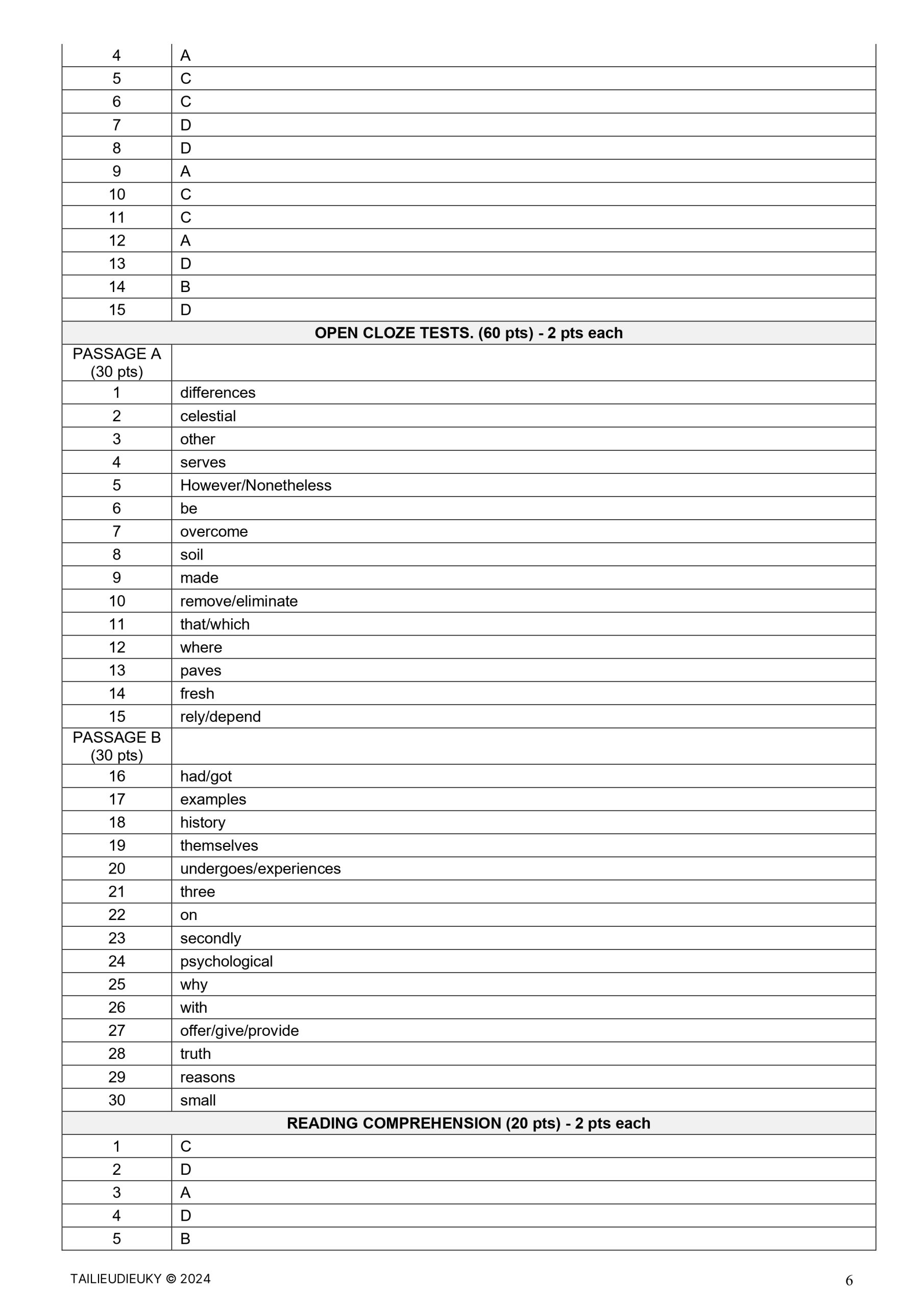
Đáp án chính thức - Đề thi HSG Tiếng Anh 12 TP Hồ Chí Minh năm học 2023-2024 - Trang 2
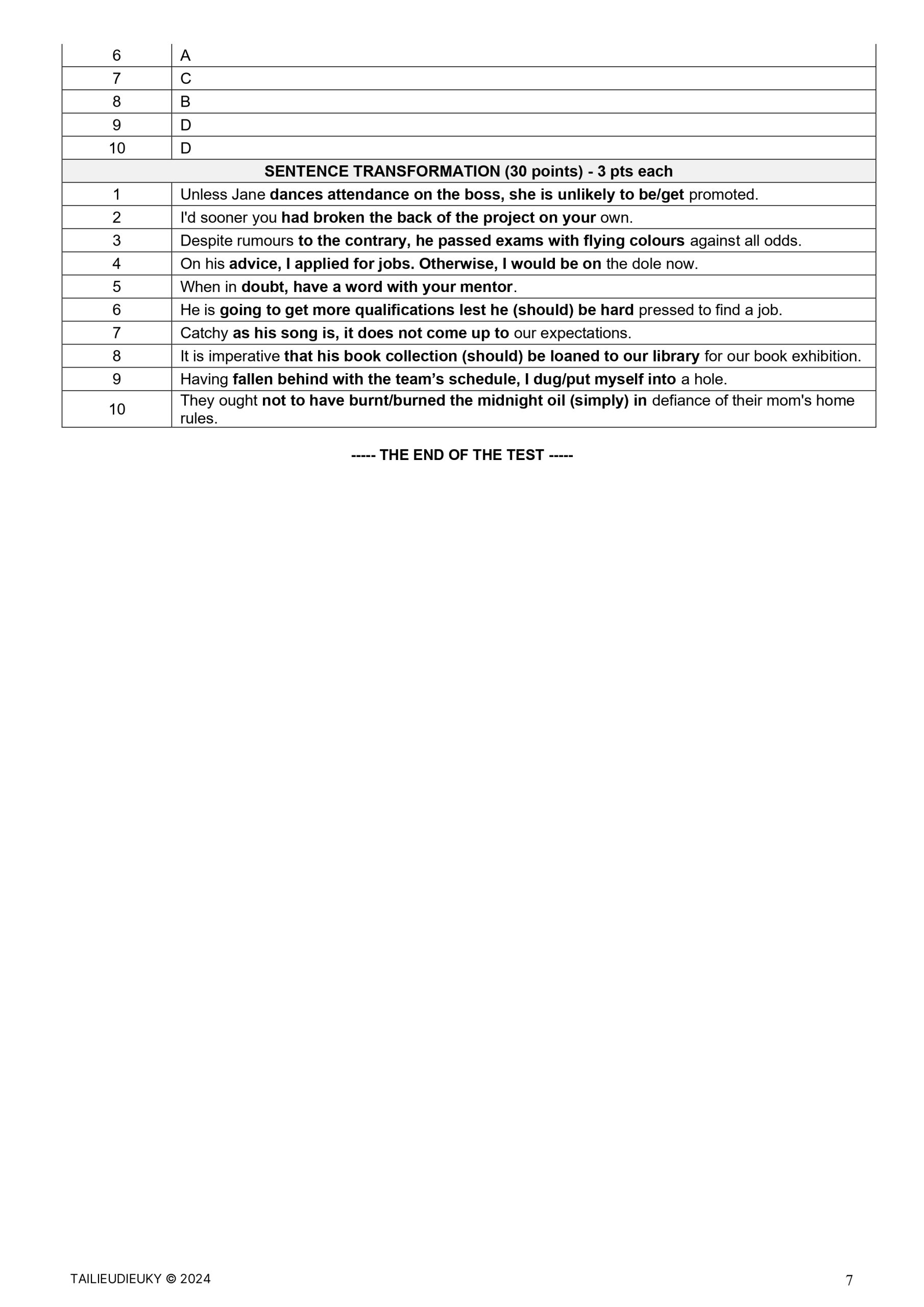
Đáp án chính thức - Đề thi HSG Tiếng Anh 12 TP Hồ Chí Minh năm học 2023-2024 - Trang 3
Để đáp ứng nhu cầu bồi dưỡng và chuẩn bị cho Kỳ thi chọn học sinh giỏi lớp 12 THPT cấp tỉnh/thành phố đặc biệt tại TP HCM, không chỉ thầy cô giáo mà cả các bạn học sinh cũng có thể tìm thêm tài liệu hữu ích trên [Danh mục HSG Tiếng Anh 12] trên website. Đây là nguồn tài liệu đa dạng và được cập nhật thường xuyên, giúp các bạn nắm bắt những kiến thức mới nhất và làm quen với các dạng đề thi chọn học sinh giỏi bậc THPT mới nhất từ 63 tỉnh thành trên cả nước.
Trích dẫn nội dung Đề thi chọn HSG TP HCM lớp 12 môn Tiếng Anh năm học 2023-2024:
SỞ GIÁO DỤC VÀ ĐÀO TẠO
THÀNH PHỐ HỒ CHÍ MINH
(Đề thi gồm 04 trang)
KỲ THI CHỌN HỌC SINH GIỎI LỚP 12 CẤP THÀNH PHỐ
NĂM HỌC 2023-2024
MÔN: TIẾNG ANH
Ngày thi: 05/03/2024
Thời gian làm bài: 120 phút, không kể thời gian phát đề
USE OF ENGLISH (20 pts)
Choose the word or phrase (A, B, C, or D) that best completes the sentence.
1. I have never read _______ before.
A. such good article B. so good article C. so good an article D. such good an article
2. Almost everyone voiced their approval of his proposal that a special scheme _______ to tackle unemployment.
A. is adopted B. be adopted C. will be adopt D. has to adopt
3. My uncle was a great believer in regular exercise. He always _______.
A. said us to work out regularly B. told us work out regularly
C. said to work out regularly D. told to work out regularly
4. _______ each group would work on a different part of the project.
A. It was agreed that B. To be agreeing that C. Agreeing that D. Having been agreed that
5. He stormed out of the hall, _______ down several chairs as he went.
A. knocked B. knocks C. knocking D. to knock
6. They tried to _______ on their children the importance of a good education.
A. highlight B. instil C. impress D. underline
7. Ever since her first home-baked cake, baking has _______ her.
A. grown on B. taken to C. got into D. likened to
8. She looked at the two versions of the same book; then she decided on _______.
A. the more expensive one out of the two B. the one that is more expensive than the two
C. the more expensive of the two D. the less expensive than the two
9. Not until the last week of the course _______ the format of the final test.
A. did the teacher mention B. that the teacher mentioned
C. the teacher mentioned D. when did the teacher mention
10. The heated debate continued for nearly an hour, _______ the chairperson intervened to suggest a compromise.
A. in which case B. by which point C. during which time D. at which point
11. After his repeated violations of school policy, the administration decided to _______ the student from the institution.
A. expel B. excel C. reject D. push
12. With their business thriving in its current location, the owners chose to renew the _______ for another five years.
A. rate B. passport C. lease D. endorsement
13. On the _______, the merger appeared to benefit both companies, but deeper analysis revealed underlying challenges.
A. edge B. surface C. sidelines D. limit
14. The company has _______ its headquarters to a more economically advantageous region to cut costs and attract talent.
A. withdrew B. commuted C. persevered D. relocated
15. With the final seconds ticking down and the score tied, the championship title was on the _______ as John took the shot.
A. edge B. line C. ceiling D. sack
16. Without a strong _______ to succeed, many talented individuals find themselves struggling to achieve their full potential.
A. drive B. sense C. character D. state
17. Our innovative scheme has proved cost-effective, and the management board are eager to _______ in on the act.
A. get B. go C. hand D. foot
18. The environmental report struck a warning _______ about the rapid deforestation in the area, urging immediate action to prevent irreversible damage to the ecosystem.
A. sound B. tone C. note D. beat
19. The local government decided to strictly _______ the new traffic laws to reduce the city’s alarming number of accidents.
A. compel B. enforce C. exert D. insist
20. Many young readers _______ with the protagonist in the novel, seeing their own struggles and aspirations reflected in his journey towards self-discovery.
A. relate B. reflect C. identify D. match
WORD FORMS (40 pts)
A. Use the correct form of the word given to fill in each blank. (20 pts)
1. The new banking software streamlined the processing of financial _______ so as to make them faster and more secure. (act)
2. The product was _______ launched since we hadn’t completed the quality assurance tests. (maturity)
3. The new security system is designed to be _______, ensuring that unauthorised access is virtually impossible. (fool)
4. The film was a(n) _______ success that earned millions at the box office and received critical acclaim. (run)
5. To encourage recycling, the city installed _______ for paper, plastic, and glass in all public areas. (receive)
6. Customs officials seized a shipment of _______ goods hidden among the cargo, highlighting the ongoing battle against illegal trade. (ban)
7. The decision to invest heavily in outdated technology was _______ and led to significant financial loss. (guide)
8. The _______ of the old mansion is quite expensive as it requires constant repairs and renovations. (keep) 9. Archaeologists hope to _______ significant artifacts from the ancient site that could shed light on early human civilisations. (earth)
10. The proposal to reduce working hours without adjusting pay was a(n) _______ for the negotiation team. (start)
B. Put the words given in the correct blanks. You have to use their correct forms to make a meaningful passage. There are two words that you cannot use. (20 pts)
desert expansion cultivate add erode intrusion
economy frequency compulsion exclude danger precede
While some poachers are driven by sheer cruelty and greed, it’s generally understood that most engage in poaching out of (11) _______ need. Similarly, in overpopulated countries, communities (12) _______ into wilderness areas in search of living space and increasingly (13) _______ on the habitats of wild animals. This leads to more (14) _______ encounters and conflicts with natural predators, contributing to the decline in wildlife populations. Survival often takes (15) _______ over environmental concerns. Instinct and a sense of duty to protect their families drive farmers and community leaders to hunt (16) _______ animals that threaten their villages at night. (17) _______, many of these communities depend on agriculture and livestock for their income. When predators threaten their animals, they feel (18) _______ to eliminate the danger. The need for grazing land for livestock and land for crop (19) _______ also pushes communities to expand agricultural areas, which means deforestation and soil degradation. This loss of trees and nutrients exacerbates (20) _______ where fertile land turns into desert. Altogether such destruction of ecosystems severely endangers the survival of many wild species.
GUIDED CLOZE TEST (30 pts)
Read the passage and choose the best option (A, B, C or D) for each blank space.
The Amondawa, (1) _______ live in a remote, forested area of the Brazilian state of Rondonia, were first (2) _______ by the outside world in 1986. Traditionally they have lived by small-scale farming, hunting and fishing. Like many other Amazonian languages, (3) _______ has a very restricted number vocabulary, with only four numbers, so the (4) _______ of clock time and a numerically based calendar is hardly surprising. For the Amondawa, time during the day is marked by the sun’s (5) _______ in the sky, and by activities such as rising, eating and working that habitually take place at different times. With no words for month and year, longer intervals are named as subdivisions of the dry and rainy seasons. The language has no abstract (6) _______ for time, and when asked to (7) _______ the Portuguese word tempo, speakers use the word kuara, or sun. (8) _______ do the Amondawa celebrate birthdays. People pass through named life (9) _______, taking on a new personal name based on gender and clan with each transition. When a new baby is born, for example, it will take the name of its older (10) _______ and that child will adopt a different name. Having no calendar or other number-based time- measurement system, the Amondawa have no (11) _______ concept of “abstract” time. Their time intervals are structured around the rhythms of the natural and social world, rather than being segments of a calibrated timeline independent of and superimposed upon these worlds. Amondawa time, to (12) _______ it another way, is identical to the events and routines of everyday life, rather than being, as it is for us, a “technology of the mind” used for organising those events and routines. Amondawa time (13) _______ us as odd and remarkable. But taking a longer (14) _______ of human culture, traditional societies like the Amondawa can manage without the cognitive technologies of calendar and clock. It seems that our experience of time (15) _______ as much to cultural invention as to the workings of the brain.
1. A. who B. that C. which D. they
2. A. communicated B. contacted C. interfered D. interacted
3. A. it B. theirs C. which D. that
4. A. lack B. rarity C. shortage D. non-appearance
5. A. site B. location C. position D. place
6. A. technically B. expression C. term D. reference
7. A. interpret B. paraphrase C. reword D. translate
8. A. So B. Either C. Never D. Neither
9. A. stages B. phrases C. periods D. steps
10. A. cousin B. relative C. sibling D. relation
11. A. relevant B. respective C. corresponding D. correlative
12. A. put B. express C. name D. make
13. A. balances B. impresses C. regards D. strikes
14. A. sight B. view C. look D. study
15. A. traces B. belongs C. comes D. owes
OPEN CLOZE TESTS. (60 pts)
Fill in each of the blanks in the following passages with ONE suitable word.
PASSAGE A (30 pts)
The absence of trees and plants in the extraterrestrial environments is one of the stark (1)_______ between Earth and other (2) _______ bodies. However, scientists around the world are developing methods to cultivate in space and on (3) _______ planets, which could revolutionize long-duration space exploration and habitation on the moon or Mars.
Growing plants in space isn’t just about aesthetics; it (4) _______ practical purposes: food source, psychological benefits, oxygen production and soil enrichment. (5) _______, cultivating plants in the harsh environments of space is hindered by extreme temperatures, harmful radiation, and the absence of gravity. The unique conditions of space mean plants cannot (6) _______ grown outside protective habitats. The International Space Station (ISS) researchers are perfecting technologies, like special lighting and root-wrapping sponges, to (7) _______ the challenges posed by microgravity: disoriented root growth and complicated watering.
The (8) _______ on the moon and Mars is toxic and nutrient-poor, yet advances are being (9) _______. A team of astronauts have successfully cultivated chickpeas using lunar soil amended with worms and fungi to balance nutrients and (10) _______ toxins, with promising results (11) _______ hint at the potential for off-world agriculture.
These efforts are not merely scientific pursuits; they are crucial steps toward a future (12) _______ humans can sustain themselves on other planets. With the combined challenges of extraterrestrial soil composition, absence of gravity, and extreme space conditions, the research (13) _______ the way for future astronauts to possibly enjoy (14) _______ produce, contributing to both their physical and psychological well-being. As these methods improve, the hope is that astronauts will be able to (15) _______ less on carried supplies and more on renewable, self-produced food sources, making the dream of living beyond Earth more tangible.
PASSAGE B (30 pts)
What’s the similarity between a story about children finding a house built of sweets and one about someone waking up in a bath of ice having (16) _______ a kidney removed in their sleep? Academics argue that they are both (7) _______ of folklores, simply separated by time.
Throughout (18 _______, folklore has served complex social functions, and with the circulation of urban myths today, it remains meaningful, even if the stories (19) _______ have changed dramatically. In academic terms, folklore means stories that are repeated by different individuals and that (20) _______ variations over time, often becoming exaggerated and sensationalised.
Most scholars attempt to decode the meanings of stories in one of (21) _______ main ways: firstly, there are those who focus (22) _______ the structure and literary merits of stories; (23) _______, there’s the more cultural approach, which explores historical, social and economic contexts; and finally, there’s the more (24) _______ approach, which concentrates on the reasons (25) _______ people create and spread stories.
Many urban myths deal (26) _______ topics such as crime, accidents and death and seem to emerge from deep-rooted fears people have about the world and from the need to (27) _______ lessons about these anxieties.
While urban legends aren’t necessarily true, the popular ones nevertheless have a ring of (28) _______ about them. Listeners then spread them for a whole range of different (29) _______: out of boredom, to voice personal worries, to get attention, to harm or simply to make (30) _______ talk.
READING COMPREHENSION (20 pts)
Choose the item (A, B, C or D) that best answers each question or completes the sentences about the passage.
White created by light – on a TV screen, for example, or through a prism – does not have its own specific wavelength. Rather, it is the sum of all the colours. Think of a rainbow: you can’t see the colours of sunlight except when raindrops refract the light rays and reveal the whole spectrum. Because of this, scientists do not generally count white as a colour.
However, in your day-to-day life, you can go to any DIY shop and see endless shades of white huddling together in the paint section. So when it comes to pigment, rather than light, white is most definitely a colour.
In prehistoric times, our ancestors used white chalk to create their art. Readily available, chalk is a kind of limestone made of the mineral calcite, which can be crushed easily to create not just cave paintings, but giant artworks, such as Uffington’s white horse or the Cerne Abbas giant.
In written records, the earliest mention of a white pigment that is not plain chalk comes from the Italian artist Cennino Cennini in the 13th century. He used the term “Bianco di San Giovanni” to describe a white lime pigment made of calcium carbonate and calcium hydroxide. Artists dried out lime, then reduced it to a white powder that was immersed in water for eight days, with the water changed each day. It was then made into small cakes that were left to dry in the sun.
The other way to make white was to use lead. The process was described by Pliny the Elder: pieces of lead were put into clay pots that had a separate compartment filled with vinegar. These were piled on shelves next to cow dung. Over a month or so, the fumes coming from the vinegar and the cow dung caused the lead to corrode into lead carbonate, a beautiful white compound that was, unfortunately, pretty toxic. Lead white was actually the only white used in European paintings until the 19th century, when its manufacture was finally restricted. Now, in the EU, lead paint can now only be used for the restoration of works of art and historical buildings.
For much of human history, white has been a symbol of purity. It was worn by priestesses in ancient Egypt and Rome, while ancient temples were faced with white marble. The Pope has worn white since 1566, as a symbol of purity and sacrifice, and it is worn by pilgrims in Islam and the Shinto religion of Japan.
We all think of white as having a place at weddings – the white dress worn by brides symbolises virginal innocence and new beginnings. Interestingly, white used to be reserved solely for royal weddings – non-royals just wore their Sunday best – up until the 19th century, when Queen Victoria’s lace wedding dress inspired a fashion for white.
White is also the colour most associated with cleanliness. Laundry powders promise to get your clothes “whiter than white” – because white means clean. Refrigerators and dishes, toilets and sinks, bed linen and towels are all traditionally white. White was the traditional colour of the coats worn by doctors, nurses, scientists and laboratory technicians, and it’s often worn by chefs, bakers and butchers.
White is best for a fresh start. It’s a blank canvas, it’s a new page. Start with white and you’ll be all right (unless you’re applying makeup, that is).
1. Why does the writer say that white is not scientifically a colour?
A. White is only created by TV screens. B. White has many shades.
C. White consists of all the colours. D. White is on a special wavelength.
2. According to the passage, sunlight _______.
A. has no colour at all B. has different wavelengths at different times of the day
C. reveals the whole spectrum of rainbow D. is similar to white produced by light through a prism
3. What material does the writer say was used before recorded history?
A. Early humans used lime to create art. B. Chalk was used to create artwork.
C. People first used lead for cave paintings. D. Animal dung was essential to prehistoric art.
4. What does the writer imply is true about the first documented process of making white pigment?
A. White lime pigment was a combination of calcium and lime.
B. It was a totally immersive process.
C. It was poisonous and dangerous to manufacturers.
D. It was not a quick process to make a white pigment.
5. What does the writer refer to with the word “these” in paragraph 5?
A. artists B. clay pots C. pieces of lead D. separate compartments
6. What does the writer say is true about modern uses of lead paint?
A. Its use is strictly controlled. B. It is used in the manufacture of paintings.
C. It is solely used in building renovations. D. It is widely used across Europe.
7. How does the writer summarize the cultural meaning of white?
A. He describes it as sacrificial colour used primarily in religious rites.
B. He states it should be used for royal weddings.
C. He illustrates that white represents the absence of evil, guilt, and contamination.
D. He says many professionals wear white to inspire confidence.
8. How many ways of making white pigments used for paintings are mentioned in the passage?
A. 2 B. 3 C. 4 D. 5
9. Lead white _______.
A. is quite user- friendly B. was used together with plain chalk in EU in the 1800s
C. is no longer in use now D. was produced in more than a month
10. Which of the following is NOT associated with white?
A. cleanliness B. sacrifice C. new beginnings D. royalty
SENTENCE TRANSFORMATION (30 points)
Rewrite each sentence in such a way that it means almost the same as the one printed before it. Use the word in brackets without making any change to it. Write NO MORE THAN TEN WORDS.
1. Keeping on acting against the boss’s will, Jane stands no chance of promotion. (UNLIKELY)
=> Unless Jane dances _________________________________________________________________ promoted.
2. Why didn’t you complete the main part of the project by yourself? (BACK)
=> I’d sooner ______________________________________________________________________________ own.
3. Contrary to rumours, he achieved very high marks in exams regardless of numerous difficulties. (FLYING)
=> Despite _______________________________________________________________________ against all odds.
4. I’m in paid employment now because I took his advice and applied for jobs. (OTHERWISE)
=> On his __________________________________________________________________________ the dole now.
5. When you are not sure what to do, talk to your mentor. (WORD)
=> When in ___________________________________________________________________________________.
6. He plans to get more qualifications so that he won’t have difficulty finding a job. (LEST)
=> He is _____________________________________________________________________ pressed to find a job.
7. His song is catchy, but we find it a let-down. (COME)
=> Catchy ______________________________________________________________________ our expectations.
8. Our library has to borrow his book collection for our book exhibition. (LOANED)
=> It is imperative ____________________________________________________________ for our book exhibition.
9. My failure to keep pace with the team’s schedule put me in trouble. (BEHIND)
=> Having _______________________________________________________________________________ a hole.
10. Foolishly, they worked till very late at night simply because they were against their mom’s home rules. (OIL)
=> They ought _____________________________________________________ defiance of their mom’s home rules.
----- THE END OF THE TEST -----
SỞ GIÁO DỤC VÀ ĐÀO TẠO
THÀNH PHỐ HỒ CHÍ MINH
(Đề thi gồm 04 trang)
KỲ THI CHỌN HỌC SINH GIỎI LỚP 12 CẤP THÀNH PHỐ
NĂM HỌC 2023-2024
MÔN: TIẾNG ANH
Ngày thi: 05/03/2024
Thời gian làm bài: 120 phút, không kể thời gian phát đề
ĐÁP ÁN CHÍNH THỨC
USE OF ENGLISH (20 pts) - 1 pt each
1 C
2 B
3 C
4 A
5 C
6 C
7 A
8 C
9 A
10 D
11 A
12 C
13 B
14 D
15 B
16 A
17 A
18 C
19 B
20 C
WORD FORMS (40 pts) - 2 pts each
1 transactions
2 prematurely
3 foolproof
4 runaway
5 receptacles
6 contraband
7 misguided
8 upkeep
9 unearth
10 non-starter
11 economic
12 expand
13 intrude
14 frequent
15 precedence
16 dangerous
17 Additionally
18 compelled
19 cultivation
20 desertification
GUIDED CLOZE TEST (30 pts) - 2 pts each
1 A
2 B
3 B
4 A
5 C
6 C
7 D
8 D
9 A
10 C
11 C
12 A
13 D
14 B
15 D
OPEN CLOZE TESTS. (60 pts) - 2 pts each
PASSAGE A (30 pts)
1 differences
2 celestial
3 other
4 serves
5 However/Nonetheless
6 be
7 overcome
8 soil
9 made
10 remove/eliminate
11 that/which
12 where
13 paves
14 fresh
15 rely/depend
PASSAGE B (30 pts)
16 had/got
17 examples
18 history
19 themselves
20 undergoes/experiences
21 three
22 on
23 secondly
24 psychological
25 why
26 with
27 offer/give/provide
28 truth
29 reasons
30 small
READING COMPREHENSION (20 pts) - 2 pts each
1 C
2 D
3 A
4 D
5 B
6 A
7 C
8 B
9 D
10 D
SENTENCE TRANSFORMATION (30 points) - 3 pts each
1 Unless Jane dances attendance on the boss, she is unlikely to be/get promoted.
2 I'd sooner you had broken the back of the project on your own.
3 Despite rumours to the contrary, he passed exams with flying colours against all odds.
4 On his advice, I applied for jobs. Otherwise, I would be on the dole now.
5 When in doubt, have a word with your mentor.
6 He is going to get more qualifications lest he (should) be hard pressed to find a job.
7 Catchy as his song is, it does not come up to our expectations.
8 It is imperative that his book collection (should) be loaned to our library for our book exhibition.
9 Having fallen behind with the team’s schedule, I dug/put myself into a hole.
10 They ought not to have burnt/burned the midnight oil (simply) in defiance of their mom's home rules.
----- THE END OF THE TEST -----
